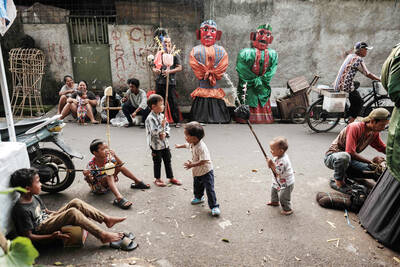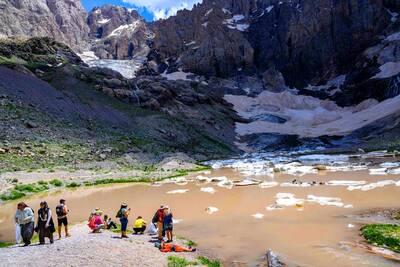The Philippine health secretary said yesterday that firecracker injuries dropped considerably during New Year celebrations, thanks to a scare campaign that included bloody images of revelry gone wrong.
The number of Filipinos injured by firecrackers and celebratory gunfire from Dec. 21 to Jan. 1 dropped by nearly half to 439 compared with the previous year, and there were no immediate reports of deaths, Health Secretary Francisco Duque III said yesterday.
It was the lowest number of injures in eight years, he said.
"Filipinos chose to be safer this year," Duque said at a news conference, which he traditionally holds on Jan. 1 to announce the gory details of firecracker blast injuries and deaths.
"The effective strategy was showing the public the incontrovertible horror of losing their limbs and possibly their lives," he said.
Last week, Duque showed the media a father and son who lost their arms to a powerful firecracker blast in 2006 in Manila. He also showed a long surgical saw, pliers and a syringe with a 12.7cm needle -- the tools used to amputate the limbs of firecracker blast victims.
Local TV networks repeatedly showed gory scenes from last year's New Year's eve celebrations, including blood-splattered victims yelling in pain in hospital emergency rooms as doctors attended to their wounds.
Organized fireworks displays in public parks and near shopping centers and the hard economic times also helped discourage many Filipinos from setting off firecrackers in their neighborhoods, officials said.
Despite the government campaign, Manila and other cities resembled war zones late on Monday as the New Year approached. Powerful firecracker blasts could be heard booming everywhere, and neighborhoods and commercial districts were shrouded in dark-gray smoke. Ambulance sirens later wailed as the wounded were brought to hospitals.
However, the explosions were over in less than an hour -- markedly shorter than in years past -- and a drizzle later helped clear the smoke from Manila.
Duque said about 30 percent of those injured by firecrackers were children under 10 years old.
He said he would ask Congress to permanently ban firecrackers in neighborhoods, but acknowledged that it would be difficult to stop the ingrained tradition, partly because thousands of poor Filipinos depend on the legal and underground firecracker industry for a living.

In the sweltering streets of Jakarta, buskers carry towering, hollow puppets and pass around a bucket for donations. Now, they fear becoming outlaws. City authorities said they would crack down on use of the sacred ondel-ondel puppets, which can stand as tall as a truck, and they are drafting legislation to remove what they view as a street nuisance. Performances featuring the puppets — originally used by Jakarta’s Betawi people to ward off evil spirits — would be allowed only at set events. The ban could leave many ondel-ondel buskers in Jakarta jobless. “I am confused and anxious. I fear getting raided or even

Kemal Ozdemir looked up at the bare peaks of Mount Cilo in Turkey’s Kurdish majority southeast. “There were glaciers 10 years ago,” he recalled under a cloudless sky. A mountain guide for 15 years, Ozdemir then turned toward the torrent carrying dozens of blocks of ice below a slope covered with grass and rocks — a sign of glacier loss being exacerbated by global warming. “You can see that there are quite a few pieces of glacier in the water right now ... the reason why the waterfalls flow lushly actually shows us how fast the ice is melting,” he said.

Eleven people, including a former minister, were arrested in Serbia on Friday over a train station disaster in which 16 people died. The concrete canopy of the newly renovated station in the northern city of Novi Sad collapsed on Nov. 1, 2024 in a disaster widely blamed on corruption and poor oversight. It sparked a wave of student-led protests and led to the resignation of then-Serbian prime minister Milos Vucevic and the fall of his government. The public prosecutor’s office in Novi Sad opened an investigation into the accident and deaths. In February, the public prosecutor’s office for organized crime opened another probe into

RISING RACISM: A Japanese group called on China to assure safety in the country, while the Chinese embassy in Tokyo urged action against a ‘surge in xenophobia’ A Japanese woman living in China was attacked and injured by a man in a subway station in Suzhou, China, Japanese media said, hours after two Chinese men were seriously injured in violence in Tokyo. The attacks on Thursday raised concern about xenophobic sentiment in China and Japan that have been blamed for assaults in both countries. It was the third attack involving Japanese living in China since last year. In the two previous cases in China, Chinese authorities have insisted they were isolated incidents. Japanese broadcaster NHK did not identify the woman injured in Suzhou by name, but, citing the Japanese